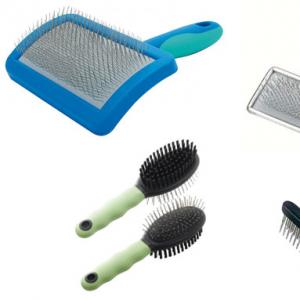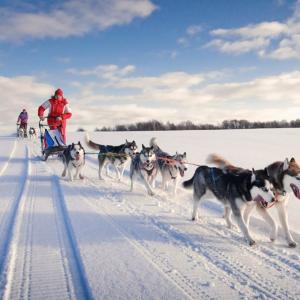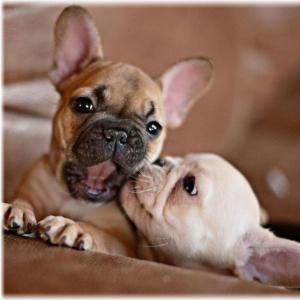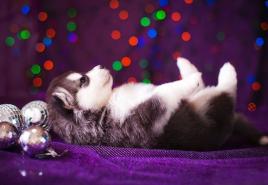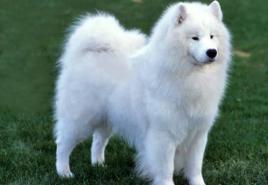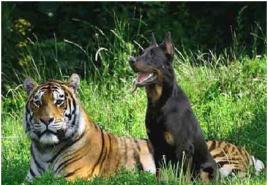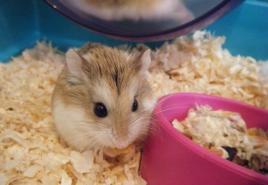French Shepherds: Briard, Beauceron.
Briard(long-haired French Shepherd). Bulky in appearance, Briards are strong and agile dogs with a great sense of self-esteem. They are agile, balanced, courageous and energetic. Behind the rough exterior lies a creature with a heart of gold. Very affectionate, loyal and playful. They are attached to their owner, love to play with children, although they are reserved with strangers. The Briard is a classic herding dog, one of the ancient French breeds, native to the same region of France that gave the world the world's most popular variety of cheese. The first mentions of it can be found in literary sources of the 12th century, but briards appeared at exhibitions only in 1863. Like the Beauceron, the Briard is descended from the "plains dogs" that were common near Paris. The name Briard was first used to designate the breed at an agricultural exhibition at the Abbey of Rosier in 1809. At the first dog show in Paris in 1863, the winner was a female breed resembling the modern Briard. P. Megnin wrote about the briard in 1888 in the magazine “L’Eleveur”: “Briard is a cross between a barbe and a Berger de Beauce, its distinctive feature is the long coat of the fleece type.” The breed was first registered in 1885. The first standard was drawn up by the Briard Club in 1897. It considered 2 varieties: with long wool of the sheep and goat type (by wool of the sheep type is meant long, soft, curly wool, goat type - tougher, coarser, straight wool). Subsequently, it was the second that prevailed, which was enshrined in the 1988 FCI standard, later modified and set out in the 1995 edition. 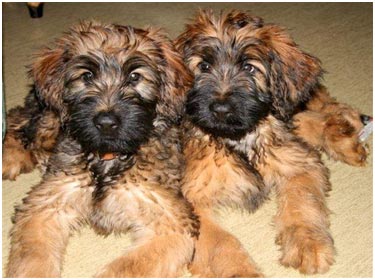 Since for centuries Briards protected large and small livestock from predators, they developed protective instincts perfectly and therefore, during the First World War, Briards were used as guard dogs. Nowadays, Briards have of course less work in the shepherd service, however, Shepherd's talents will still find use today, especially in large families. Briard knows how to take good care of children, the fact is that Briards perceive children as “their pack”, which must be looked after in every possible way, ensuring their complete safety. But we must not forget that the dog is the face of the owner, and a puppy of any breed should be started to be raised immediately after it appears in the house. Any puppy, even with the most ideal psyche, can be turned into a moral monster simply, it would seem, “by doing nothing.”
Since for centuries Briards protected large and small livestock from predators, they developed protective instincts perfectly and therefore, during the First World War, Briards were used as guard dogs. Nowadays, Briards have of course less work in the shepherd service, however, Shepherd's talents will still find use today, especially in large families. Briard knows how to take good care of children, the fact is that Briards perceive children as “their pack”, which must be looked after in every possible way, ensuring their complete safety. But we must not forget that the dog is the face of the owner, and a puppy of any breed should be started to be raised immediately after it appears in the house. Any puppy, even with the most ideal psyche, can be turned into a moral monster simply, it would seem, “by doing nothing.”
And Briard puppies are so touching that, often, their owners treat them like toys and do not notice how the little fluffy bear cub has already turned into a big beast and controls your family at its own discretion. Therefore, it is very important not to miss this favorable period for the formation of behavioral reactions.  Such a serious task as raising a dog should not be entrusted to children. Communicate - yes, but the Briard must have an authoritative owner, whom he will respect, and who can stop the attempts of the maturing dog to become a leader and take over the pack - the family. A teenage Briard will explore your psyche unnoticed by you, can easily find vulnerabilities and take advantage of your slightest weakness in order to get a place higher in the hierarchy of the pack. You need to understand that a briard cannot be forced to do anything by force, do not try to do this under any circumstances - the briard may be offended by undeserved punishment and you will lose all your well-deserved authority in his eyes, which will not be so easy to return. He will analyze any request or order, and carries it out only if he considers it appropriate. But it is precisely this feature that makes the dog an amazing student - inquisitive, tireless, and proactive. Fortunately, Briards are easy to train, especially (like all breeds) at a young age, since their thirst for knowledge is simply amazing. Briards love to be helpful. It is always a joy for them to serve their master. In addition, they are distinguished by excellent memory. Dogs are capable of performing universal functions: following a scent, chasing an animal, serving in the army as guard dogs, searching for the wounded. These qualities led to the widespread use of Briards during both World Wars, which nearly resulted in the near extinction of this valuable sheepdog. However, the number of livestock was restored in time. A wonderful universal dog, the French Longhaired Shepherd is still not suitable for every family. This is due to the fact that Briards cannot stand a sofa existence and quickly lose interest in life in the absence of regular emotional and physical stress, despite their apparent decorativeness. Apartment maintenance requires long walks and great physical activity, such as cross-country, cycling, etc. Without work for the head and muscles, a dog can turn into an unhappy, embittered animal. Briard enjoys variety - new games, new places, new people. Briards love not only new people, but also any manifestation of attention on their part; they are willing to make contact, but at the same time do not allow them to become overly familiar. The Briard is very attached to its beloved owner. This dog absolutely cannot stand loneliness and cannot live without its family.
Such a serious task as raising a dog should not be entrusted to children. Communicate - yes, but the Briard must have an authoritative owner, whom he will respect, and who can stop the attempts of the maturing dog to become a leader and take over the pack - the family. A teenage Briard will explore your psyche unnoticed by you, can easily find vulnerabilities and take advantage of your slightest weakness in order to get a place higher in the hierarchy of the pack. You need to understand that a briard cannot be forced to do anything by force, do not try to do this under any circumstances - the briard may be offended by undeserved punishment and you will lose all your well-deserved authority in his eyes, which will not be so easy to return. He will analyze any request or order, and carries it out only if he considers it appropriate. But it is precisely this feature that makes the dog an amazing student - inquisitive, tireless, and proactive. Fortunately, Briards are easy to train, especially (like all breeds) at a young age, since their thirst for knowledge is simply amazing. Briards love to be helpful. It is always a joy for them to serve their master. In addition, they are distinguished by excellent memory. Dogs are capable of performing universal functions: following a scent, chasing an animal, serving in the army as guard dogs, searching for the wounded. These qualities led to the widespread use of Briards during both World Wars, which nearly resulted in the near extinction of this valuable sheepdog. However, the number of livestock was restored in time. A wonderful universal dog, the French Longhaired Shepherd is still not suitable for every family. This is due to the fact that Briards cannot stand a sofa existence and quickly lose interest in life in the absence of regular emotional and physical stress, despite their apparent decorativeness. Apartment maintenance requires long walks and great physical activity, such as cross-country, cycling, etc. Without work for the head and muscles, a dog can turn into an unhappy, embittered animal. Briard enjoys variety - new games, new places, new people. Briards love not only new people, but also any manifestation of attention on their part; they are willing to make contact, but at the same time do not allow them to become overly familiar. The Briard is very attached to its beloved owner. This dog absolutely cannot stand loneliness and cannot live without its family.
FCI standard 113/09.11.1995/
Country of origin: France.
Date of publication of the original standard: 05/06/1988
FCI classification:
Group 1: Shepherds and cattle herders (except Swiss Shepherds)
Section 1: Shepherds with working test
GENERAL FORM:
A strong, flexible, muscular and proportional dog, with energetic movements, a balanced character, neither aggressive nor timid.
Disadvantages: aggressiveness, effeminacy, timidity, clumsiness.
SIZE:
0.62 -0.68 m for males; 0.56-0.64 m for females. The length of the body should be greater than the height at the shoulders. The overall appearance of the briar is more important than its height.
Flaws:
Short dogs are undesirable. Height is more than 0.68 m and 0.64 m.
Disqualification: height below the minimum, more than 2 cm above the maximum. All specimens below the minimum size cannot be assessed.
HEAD:
Strong, long, the transition from the forehead to the muzzle is pronounced and is located halfway between the top of the head and the end of the nose, covered with hair that forms a beard, mustache and eyebrows, slightly hiding the eyes.
Flaws:
Short head, too long, lack of balance between muzzle and skull. Disproportion between head and body. The fur hides the outline of the head; insufficiently thick beard, mustache and eyebrows. The transition from forehead to muzzle is too sharp or unexpressed.
Disqualification: The above shortcomings are too obvious.
Forehead: slightly rounded.
Flaws: too flat, too rounded, too wide, slanted towards the eyes.
Top of muzzle: The bridge of the nose is flat.
Flaws: too long, weak, too short bridge of the nose. Convex bridge of the nose (Roman nose).
Muzzle: Neither tapered nor pointed.
Flaws: pointed, narrow or too thick muzzle, drooping lips.
Nose: more square than round, always black, strong and open.
Flaws: small nose, cramped, pointed, not black or pink-spotted.
Disqualification: brown or spotted nose, pink.
Teeth: strong, white, with correct bite.
Flaws: Missing 1 incisor
— open mouth, slight underbite (undershot) without loss of contact.
- absence of 1 premolar
- absence of 2 incisors
- absence of 2 premolars
Disqualification: Clear undershot (overbite) with loss of contact. Absence of 2 premolars 4 (PM4) in the upper jaw or absence of any 3 teeth in total, wherever they are located.
Eyes: set horizontally, well opened, widely spaced, not oblique, dark in color, with an intelligent and calm expression. Gray eyes in gray dogs are not penalized.
Flaws: eyes that are too small, almond-shaped or light-colored.
Disqualification: inappropriate eyes, haggard, too light.
Ears: set high, preferably docked and erect; not flat against the head and rather short, if not docked. If quality is equal, preference should be given to a dog with erect, cropped ears. The length of the uncropped ear should be equal to, or slightly less than, half the length of the head. Always flat and covered with long hair.
Flaws: covered with too short hair, too long, poorly standing ear.
Disqualification: curled ears, set well below the eye line, covered with short hair, naturally erect, with extended cartilage.
NECK: muscular, [high-set].
Flaws: elongated neck, too long, frail or too short.
BACK: straight.
Flaws: Slightly sagging, slightly humped back.
CROUP: slightly inclined, slightly rounded in shape.
Flaws: croup, too sloping, too straight, same faults emphasized, croup definitely higher than withers.
LIMBS: Muscular, strong boned, well set.
Flaws: Legs not [parallel], loose shoulders, too wide set hips, weak pasterns either too straight or too angled towards the toes, incorrect shoulder angle, short hair on legs, frail legs, weak bone structure
Disqualification: The front legs are seriously not parallel.
HOCK JOINTS: not too close to the ground, the leg below the joint is vertical to the ground.
Flaws: located too far from or too close to the ground, at the wrong angle.
Disqualification: The hind legs are seriously not parallel.
TAIL: undocked, with good coat, forming a hook at the end, set low, without deviations, reaching the hock joint in length, or longer, but not more than 5 cm.
Flaws:
- tail too short, lack of hook at the end, hair too short,
- the tail is held well above the line of the back,
- the tail is held under the stomach,
- The tail is held under the belly during movement.
Disqualification:
- the tail is curled like a hunting horn or held perpendicular to the back,
— traces of surgery to correct the fit of the tail shape.
PAWS: Strong, rounded in shape (intermediate between a cat's paw and a hare's paw).
Flaws:
- too long, flat, slanted,
- extra or missing fingers],
- not sufficiently covered with hair.
Disqualification: The paws are seriously not parallel.
CLAWS: black.
Flaw: gray claws.
Disqualification: White claws.
CUSHIONS: Strong.
Flaws: Not elastic, too flat, too soft pillows.
FINGERS: Strongly closed.
Flaws: fingers that are open, too long or held flat.
COAT:
Wool: Flexible, long, dry (goat hair type), with a light undercoat.
Flaws:
- not dry enough, slightly curly coat, lack of undercoat. In case of examination for admission to breeding: deferment of 6 months,
- too short coat
- fine wool.
Disqualification: the coat is shorter than 7 cm. The coat is soft or [matted].
COLOR: All solid colors are acceptable except those mentioned below. Dark colors are preferable. A two-tone color should not be confused with a slightly lighter shade at the ends of the hair, which is just the beginning of depigmentation. This shade, lighter, should remain in the same range as the main color (dark fawn - light fawn, black - lightened black, dark gray - light grey, etc.). Fawn should be warm [bright] and uniform, neither light nor faded.
Flaws:
- black with too strong a red tint (reflection),
- fawn is not bright enough, with a white spot on the chest,
- sharp distinction between dark and light shades.
- very light fawn, faded.
Disqualification: Colors: white, brown (chestnut), mahogany, two-tone. White markings, white fur on the ends of the paws. Fawn with a black cloak. The color is too light.
A note about two-tone coats: Look at the color of the skin, which will be bluish under the dark part of the coat and pinkish under the light part.
DECK FINGERS: double dewclaws on hind legs. dogs, even of very good type, which have only one dewclaw should not be judged. Such dogs are not allowed for breeding. The double dewclaws should consist of two bones with claws, and should be placed as close to the ground as possible to ensure the best possible foot placement.
Flaws:
– position too high (halfway up the hock),
- absence of two claws,
- absence of one bone in one double dewclaw.
Disqualification:
- single dewclaws,
- absence of dewclaws,
- absence of two bones in the double dewclaw, even if there are claws there,
- absence of one bone in each double dewclaw, even if there are claws.
ADMISSION for breeding use: all points of disqualification, all ratings less than good, mean the refusal of the individual for admission to breeding.
Faults: Any deviation from the preceding points must be considered a fault, and the seriousness with which the fault is to be regarded must be in exact proportion to its degree.
N.B. Males should have two clearly palpable normal testes, completely descended into the scrotum.
Beauceron(Beanceron - literally means resident of the province of Beauce), is rightfully considered one of the oldest breeds of French Shepherds (these dogs, also known as “French Shepherds,” were first mentioned in a written source in 1578). 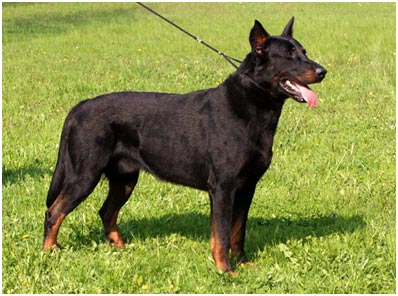 Both according to naturalists of the 18th century - Buffon, Linnaeus, Cuvier, and according to livestock specialists of the 19th century - Corneven, Menin, Deschambres - it descends in a direct line from the famous “peat dog”, who lived in the Stone Age and is the ancestor of most modern shepherd dogs , supporters of another version believe that the closest relatives of the Beaucerons are ordinary wild wolves. The second version is also supported by the fact that, according to modern research, these animals have similar genetics.
Both according to naturalists of the 18th century - Buffon, Linnaeus, Cuvier, and according to livestock specialists of the 19th century - Corneven, Menin, Deschambres - it descends in a direct line from the famous “peat dog”, who lived in the Stone Age and is the ancestor of most modern shepherd dogs , supporters of another version believe that the closest relatives of the Beaucerons are ordinary wild wolves. The second version is also supported by the fact that, according to modern research, these animals have similar genetics.
For centuries, this breed has served people, and life presents it with a variety of tasks. At first, Beaucerons were used as hunters of bears, wild boars and deer. And when hunting ceased to play such a significant role in people’s lives and gave way to agriculture, Beaucerons “retrained” as herding dogs, protecting livestock from wolves.
The breed was established in its final form by the end of the 19th century. The standard was adopted in 1863. Externally, the Beauceron is a large, powerful, muscular dog with an athletic build. It is characteristic that these dogs mature quite late - they can be considered mature only by the age of two or three. This tall, strong, but not heavy dog with graceful and graphically clear lines has another name - Bas Ronge, or “red stocking”. The usual color of the Beauceron is black with red-red tan, hence the name. but this breed has two color options: the standard one - black with tan markings (Ba Rouge - “red stockings”), and a rarer variety - the so-called harlequin, black with red tan markings and gray spots.
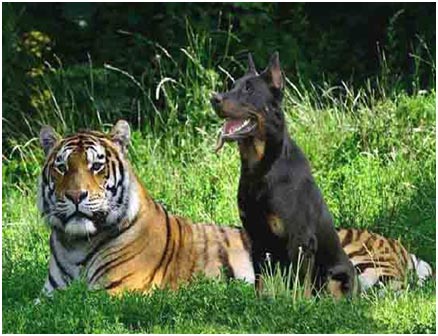 Nowadays, color (Ba Rouge - “red stockings”) is the main color for this breed; Approximately 3,800 puppies of this color are born each year. As for the harlequins (about 30-50 registrations per year), opinions differ regarding their roots. Some argue that they have always existed in the form in which we know them today. Others say that this variety is a recent development. I personally lean towards the second version, since I have not seen reliable evidence that harlequins have always existed.
Nowadays, color (Ba Rouge - “red stockings”) is the main color for this breed; Approximately 3,800 puppies of this color are born each year. As for the harlequins (about 30-50 registrations per year), opinions differ regarding their roots. Some argue that they have always existed in the form in which we know them today. Others say that this variety is a recent development. I personally lean towards the second version, since I have not seen reliable evidence that harlequins have always existed.
Beaucerons are exceptionally smart, therefore, in addition to their old shepherd profession, Beaucerons have since acquired many new specialties. The army uses them as bloodhounds, sentries, guards, explosives specialists, messengers or messengers. The police often resort to their help when they need to find injured or missing people.
Beaucerons have a very strong sense of responsibility. Endowed with an unerring memory and supernatural powers of observation, he rarely barks and only for serious reasons. The owner of a Beauceron who knows his dog well can, without leaving home, know who is approaching his home. Whether the car of someone he knows has driven up, the dog has run by, or someone stranger has passed by, he will bark as many times as happened events.
These dogs are also famous for their independence (unlike most “true” shepherd dogs); they often show their own initiative, “not sanctioned” by the owner. Therefore, they need qualified, skillful handling. 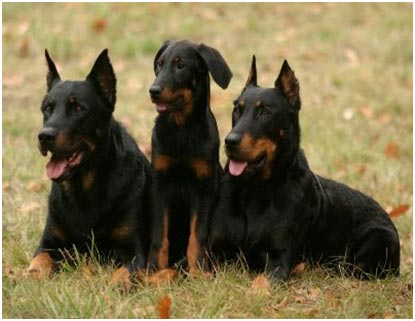 Perhaps the Beauceron is one of the most difficult dogs to train. The difficulty is that she has a very capricious character. Steadfast in her beliefs, she never follows people’s lead, so raising her is quite difficult; only a truly strong person can raise a Beauceron correctly. Beaucerons build relationships according to the pack principle. This means that either you take a strong position as a leader, and the dog becomes your devoted and loving friend, or the dog strengthens its position as a leader, and this, as you understand, is a game by completely different rules. However, this does not mean that in the process of education you need to use only force and rudeness. Intelligence, determination and consistency are your main weapons.
Perhaps the Beauceron is one of the most difficult dogs to train. The difficulty is that she has a very capricious character. Steadfast in her beliefs, she never follows people’s lead, so raising her is quite difficult; only a truly strong person can raise a Beauceron correctly. Beaucerons build relationships according to the pack principle. This means that either you take a strong position as a leader, and the dog becomes your devoted and loving friend, or the dog strengthens its position as a leader, and this, as you understand, is a game by completely different rules. However, this does not mean that in the process of education you need to use only force and rudeness. Intelligence, determination and consistency are your main weapons.
As for caring for the Beauceron, it is quite simple: experts recommend combing the dog’s coat two to three times a month, as well as regularly trimming the nails on the dewclaws.
The breed is extremely popular in France.
Excerpts from the Beauceron breed standard (FTP)
Head. Long. The forehead is flat. The transition from forehead to muzzle is poorly marked. The muzzle is elongated. Nose is black. The teeth are powerful, white, scissor bite.
Ears. Short; left in a natural state (not docked) - do not fall; docked - straight.
Back. Straight. The rear is sloping.
Limbs. Strongly muscled, with strong bones, well set. The paws are strong, the claws are black, the pads are hard. Double dewclaws on both hind legs.
Tail. Long, curved upward at the end; It is important that the dog wears it low.
Wool. Smooth on the head. On the body it is short, stiff, hard and smooth.
Color. Black, black and tan, fawn, fawn with black markings, grey, gray with black markings. For working dogs, the darker the better.
Flaws, leading to disqualification. Long hair on the face, absence of double dewclaws, docked tail, light nose, light eyes (but not in spotted dogs), shaggy coat.
The Beauceron is a fairly large dog: the height at the withers is from 60 to 69 cm.

